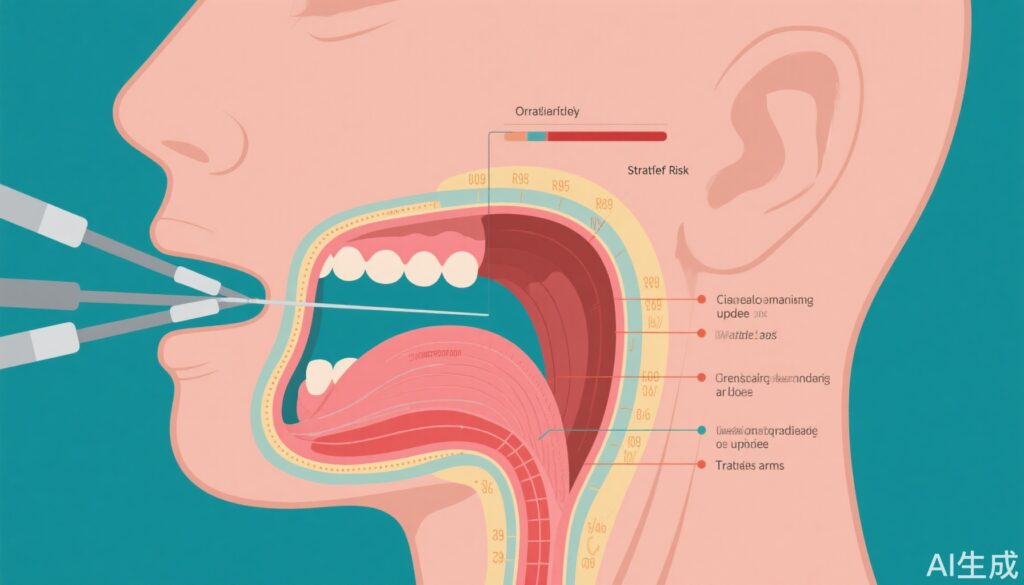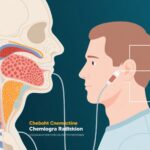Highlights
- Deintensified postoperative management after transoral surgery (TOS) in HPV-positive oropharyngeal cancer (OPC) results in outstanding 54-month progression-free and overall survival.
- Patients with favorable pathology (clear margins, minimal nodal disease) can often avoid radiation or receive reduced-dose adjuvant therapy.
- Late recurrences were observed only among N1 patients in the observation arm, highlighting the need for tailored surveillance strategies.
- No difference in survival outcomes was found between primary tumor sites or by smoking history.
Study Background and Disease Burden
Human papillomavirus (HPV)-associated oropharyngeal cancer (OPC) represents a distinct and increasingly prevalent subset of head and neck malignancies. These tumors, often arising in younger, healthier individuals, carry a better prognosis than their HPV-negative counterparts. However, conventional treatment regimens—combining surgery, radiation, and chemotherapy—are associated with significant acute and long-term toxicities, including dysphagia, xerostomia, and impaired quality of life. With rising incidence and improved survival, there is a critical need to refine therapeutic approaches to maintain excellent oncologic outcomes while reducing treatment-related morbidity.
Study Design
The E3311 trial, conducted by the ECOG-ACRIN Cancer Research Group, was a multicenter, randomized phase II study aimed at evaluating transoral surgery (TOS) followed by risk-adapted, deintensified adjuvant therapy in HPV-positive OPC. Eligible patients had resectable cT1-2, stage III/IV (AJCC 7th edition) p16+ OPC without matted neck nodes. After TOS and neck dissection, patients were stratified by pathological risk features:
- Arm A: Observation for patients with clear margins, 0-1 positive lymph nodes (LN), and no extranodal extension (ENE)
- Arm B: Randomization to 50 Gy radiotherapy for those with clear margins, 2-4 positive LN, or ENE ≤1 mm
- Arm C: Randomization to 60 Gy radiotherapy for same criteria as Arm B
- Arm D: High-risk patients (involved margins, >4 LN, or ENE >1 mm) received 60-66 Gy with weekly cisplatin
The primary endpoint was 54-month progression-free survival (PFS), with secondary endpoints including overall survival (OS) and safety.
Key Findings
A total of 359 evaluable patients were enrolled. The study demonstrated the following 54-month outcomes:
- Overall 54-month PFS: 90.6% (90% CI, 87.2%-93.1%)
- Overall 54-month OS: 95.3% (90% CI, 93.0%-96.9%)
PFS and OS by arm:
| Arm | PFS (%) | OS (%) |
|---|---|---|
| A (Observation) | 93.2 (79.6-97.8) | 97.1 (85.7-99.4) |
| B (50 Gy) | 94.9 (89.7-97.5) | 97.9 (93.5-99.3) |
| C (60 Gy) | 90.2 (82.7-94.6) | 95.1 (90.1-97.6) |
| D (60-66 Gy + Cisplatin) | 85.5 (77.5-90.8) | 92.5 (86.9-95.7) |
Notably, all four recurrences in Arm A occurred in patients with N1 disease, suggesting that even among low-risk groups, minimal nodal involvement carries a risk of late recurrence if radiation is omitted. No significant differences in PFS or OS were observed based on the primary tumor site or smoking status. The majority of patients avoided high-dose radiotherapy and chemotherapy, translating into lower anticipated long-term toxicities.
Expert Commentary
The E3311 trial addresses a crucial question in the management of HPV-positive OPC: how can clinicians safely reduce treatment intensity to mitigate toxicity without compromising efficacy? These results support a paradigm shift toward individualized, risk-adapted therapy. The observation that N1 patients remain at some risk for recurrence highlights the need for vigilant follow-up in this subgroup. While the study was not powered for direct comparison between deintensified and standard adjuvant therapy, the high survival rates are highly encouraging.
Current guidelines increasingly endorse transoral surgery followed by risk-adapted adjuvant therapy for select HPV-positive OPC patients. As Dr. Barbara Burtness and colleagues note, these findings may soon inform broader guideline revisions, emphasizing the value of surgical pathology in tailoring postoperative management. Long-term quality-of-life data, not detailed in this report but essential for patient-centered care, will further clarify the benefits of this strategy.
Conclusion
The E3311 phase II trial demonstrates that deintensified postoperative management following transoral surgery achieves excellent long-term survival in HPV-positive oropharyngeal cancer. Most patients with favorable pathology can safely avoid or reduce adjuvant therapy, minimizing long-term toxicities. However, careful surveillance is warranted for patients with nodal involvement, even if classified as low risk. These results support continued movement toward risk-adapted, patient-specific treatment paradigms in HPV-associated OPC.
References
Burtness B, Flamand Y, Quon H, Weinstein GS, Mehra R, Garcia JJ, Kim S, O’Malley BW Jr, Ozer E, Ikpeazu C, Koch WM, Gross ND, Bell RB, Patel M, Lango MN, Morris LG, Smith R, Karakla D, Richmon JD, Holsinger FC, Ferris RL. Long-Term Follow-Up of E3311, an ECOG-ACRIN Cancer Research Group Phase II Trial of Transoral Surgery and Risk-Based Adjuvant Treatment in Human Papillomavirus-Initiated Oropharynx Cancer. J Clin Oncol. 2025 Aug 10;43(23):2559-2565. doi: 10.1200/JCO-24-02550. Epub 2025 Jun 10. PMID: 40493877.


